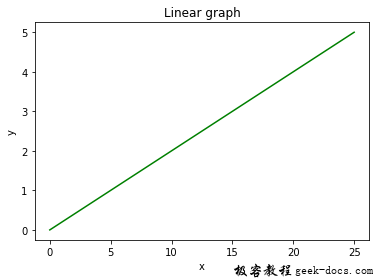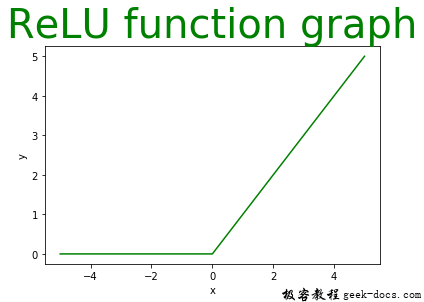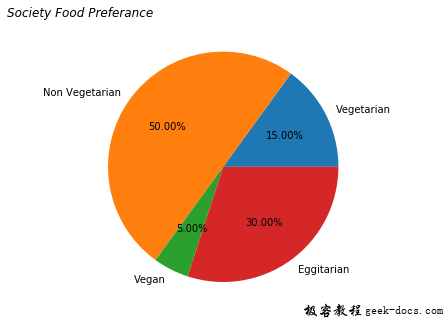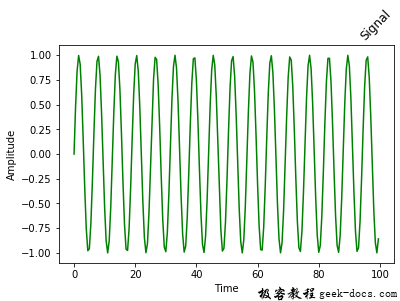matplotlib.pyplot.title()函数
Matplotlib是Python中一个非常棒的二维数组绘图可视化库。Matplotlib是一个基于NumPy数组构建的多平台数据可视化库,用于更广泛的SciPy堆栈。
Matplotlib.pyplot.title ()
matplotlib模块中的title()方法用于指定所描述的可视化的标题,并使用各种属性显示标题。
语法:matplotlib.pyplot.title(label, fontdict=None,loc= ‘ center ‘, pad=None,**kwargs)
参数:
- label (str):该参数指向所描述的可视化的实际标题文本字符串。
- fontdict (dict):该参数使用字典控制文本的外观,如文本大小,文本对齐等。下面是默认的字体:
fontdict = {‘ fontsize ‘: rcParams[‘ axes.titlesize ‘],
“fontweight”:rcParams(“轴# @titleweight”),
“verticalalignment”:“基线”,
“horizontalalignment”:loc}
- loc (str):此参数指向标题的位置,接受’center’, ‘left’和’right’等字符串值。
- pad(float):这个参数指的是标题从轴的顶端到顶点的偏移量,单位为点。它的默认值为None。
- **kwargs:该参数指的是使用其他关键字参数作为文本属性,如颜色、fonstyle、行间距、背景色、旋转等。
返回类型:title()方法返回一个表示标题文本本身的字符串。
下面是一些使用title()方法的例子:
示例1
使用matplotlib.pyplot来描绘线性图,并使用matplotlib.pyplot.title()显示其标题。
# importing module
import matplotlib.pyplot as plt
# assigning x and y coordinates
y = [0,1,2,3,4,5]
x= [0,5,10,15,20,25]
# depicting the visualization
plt.plot(x, y, color='green')
plt.xlabel('x')
plt.ylabel('y')
# displaying the title
plt.title("Linear graph")
plt.show()
输出:

在上面的例子中,只有label参数在title()方法中被赋值为“Linear graph”,其他参数被赋值为它们的默认值。label参数的赋值是显示可视化标题的最低要求。
示例2
使用matplotlib.pyplot来描绘一个ReLU函数图,并使用matplotlib.pyplot.title()显示其标题。
# importing module
import matplotlib.pyplot as plt
# assigning x and y coordinates
x = [-5,-4,-3,-2,-1,0,1,2, 3, 4, 5]
y = []
for i in range(len(x)):
y.append(max(0,x[i]))
# depicting the visualization
plt.plot(x, y, color='green')
plt.xlabel('x')
plt.ylabel('y')
# displaying the title
plt.title(label="ReLU function graph",
fontsize=40,
color="green")
输出:

上面的程序演示了label参数、fontdict参数的fontsize键和color参数的使用,color参数是一个额外的参数(由于**kwargs),它可以改变文本的颜色。
示例3
使用matplotlib.pyplot来描绘条形图,并使用matplotlib.pyplot.title()显示其标题。
# importing modules
import matplotlib.pyplot as plt
import numpy as np
# assigning x and y coordinates
language = ['C','C++','Java','Python']
users = [80,60,130,150]
# depicting the visualization
index = np.arange(len(language))
plt.bar(index, users, color='green')
plt.xlabel('Users')
plt.ylabel('Language')
plt.xticks(index, language)
# displaying the title
plt.title(label='Number of Users of a particular Language',
fontweight=10,
pad='2.0')
输出:

这里,在title()方法中使用了fontdict参数的fontweight键和pad参数,以及label参数。
示例4
使用matplotlib.pyplot来描绘饼图,并使用matplotlib.pyplot.title()显示其标题。
# importing modules
from matplotlib import pyplot as plt
# assigning x and y coordinates
foodPreference = ['Vegetarian', 'Non Vegetarian',
'Vegan', 'Eggitarian']
consumers = [30,100,10,60]
# depicting the visualization
fig = plt.figure()
ax = fig.add_axes([0,0,1,1])
ax.axis('equal')
ax.pie(consumers, labels = foodPreference,
autopct='%1.2f%%')
# displaying the title
plt.title(label="Society Food Preference",
loc="left",
fontstyle='italic')
输出:

在以上数据可视化的饼状图中,标签、字体
title()方法使用来自fontdict的关键字和fontstyle (**kwargs)参数(接受’italic’, ‘bold’和’斜体’等字符串值)来显示饼图的标题。
示例5
使用matplotlib.pyplot在图形中可视化信号,并使用matplotlib.pyplot.title()显示其标题。
# importing modules
from matplotlib import pyplot
import numpy
# assigning time values of the signal
# initial time period, final time period
# and phase angle
signalTime = numpy.arange(0, 100, 0.5);
# getting the amplitude of the signal
signalAmplitude = numpy.sin(signalTime)
# depicting the visualization
pyplot.plot(signalTime, signalAmplitude, color ='green')
pyplot.xlabel('Time')
pyplot.ylabel('Amplitude')
# displaying the title
pyplot.title("Signal",
loc='right',
rotation=45)
输出:

在这里,label参数被赋值为’signal’, loc参数被赋值为’right’,以角度为单位的rotation参数(**kwargs)被赋值为45度。
示例6
使用matplotlib.pyplot显示图像,并使用matplotlib.pyplot.title()显示其标题。
# importing modules
from PIL import ImageTk, Image
from matplotlib import pyplot as plt
# depicting the visualization
testImage = Image.open('g4g.png')
# displaying the title
plt.title("Geeks 4 Geeks",
fontsize='20',
backgroundcolor='green',
color='white')
plt.imshow(testImage)
输出:

在上面的例子中,图片的标题使用title()方法显示,参数标签为“Geeks 4 Geeks”,fontsize键从fontdict为“20”,背景色和颜色是额外的参数,字符串值分别为“绿色”和“白色”。
 极客教程
极客教程